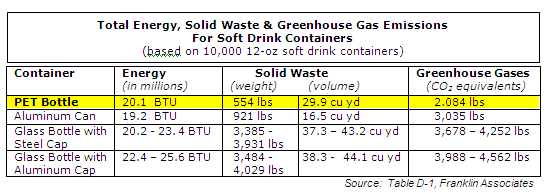Better Environmental Footprint
New York, NY (April 6, 2010)– A newly released life-cycle inventory of single-serving soda containers concludes that PET plastic bottles offer a better environmental footprint than aluminum cans or glass bottles by using less energy, generating less solid waste, and creating significantly fewer greenhouse gases.
The cradle-to-grave study, conducted by Franklin Associates for the PET Resin Association (PETRA), compared total energy, solid waste and greenhouse gas emissions per 100,000 ounces of soft drinks packaged in typical 20-oz PET bottles, 8-oz glass bottles, or 12-oz aluminum cans. The PET bottles showed appreciably lower numbers across the board.
Most notable were the lower greenhouse gas emissions for the PET bottles, which registered 59% less than aluminum and 77% less than glass. Franklin calculated the greenhouse gas emissions for the PET bottles at 1,125 pounds of carbon dioxide equivalents, compared to 2,766 lbs for aluminum and 4,949 lbs for glass.

Energy use for the PET bottles totaled 11.0 million BTU per 100,000 ounces of soft drink, compared to 16.0 million BTU for aluminum and 26.6 million BTU for glass.
Solid wastes for the PET bottles totaled 302 pounds, versus 767 pounds for aluminum, and 4,457 pounds for glass. Solid waste volume was 0.67 cubic yards for PET, 0.95 cubic yards for aluminum, 2.14 cubic yards for glass.
“This study again confirms the excellent environmental profile and value of PET for packaging foods and beverages,” said PETRA Executive Director Ralph Vasami. “Since 2005, PET containers have been the subject of several independent life-cycle analyses and PET has consistently shown itself to be a sound environmental choice whether compared to glass, metal or other plastics.”
Vasami said that after PETRA received the preliminary LCI report on the soft drink containers, it asked Franklin to go back and recalculate its findings on the basis of 10,000 equally sized 12-oz. containers. Under this scenario, the PET bottles still trumped aluminum or glass in terms of lower greenhouse gas emissions and solid wastes, while total energy use was deemed comparable for all three materials (see table below).

For both analyses, the life cycle inventory covered extraction of raw materials through container fabrication, as well as post-consumer disposal and recycling. The post-consumer disposal and recycling calculations included transporting to a landfill or incinerator, equipment operations at a landfill, and energy recovered by an incinerator, but excluded incinerator and landfill emissions. Post-fabrication transportation to the filling site, filling, distribution, storage, retail use and consumer use were excluded.
The report is available on the PETRA website at http://www.petresin.org/news.asp.
###
Contact: Ralph Vasami
Tel: (212) 297-2125
Email: [email protected]
Download Press Release: (pdf)
